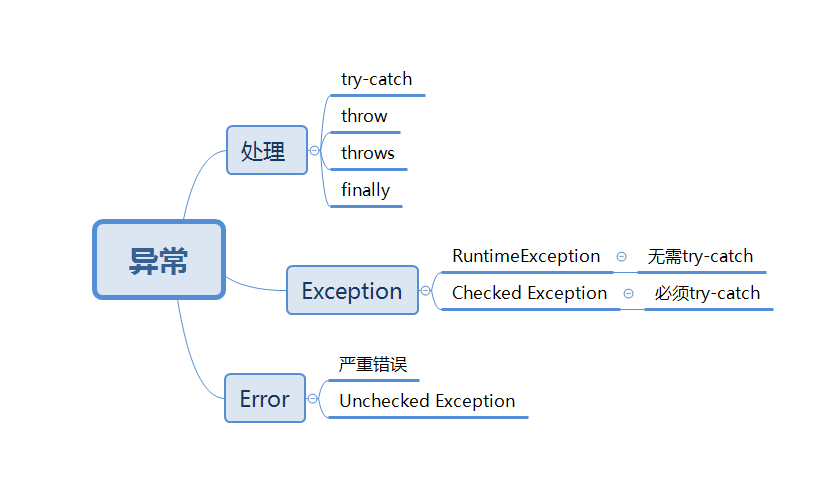1. 本周学习总结
1.1 以你喜欢的方式(思维导图或其他)归纳总结异常相关内容。

2. 书面作业
本次PTA作业题集异常
1.常用异常
题目5-1
1.1 截图你的提交结果(出现学号)

1.2 自己以前编写的代码中经常出现什么异常、需要捕获吗(为什么)?应如何避免?
自己以前编写的代码经常出现异常就是数组越界,无需使用try-catch进行捕获处理,我们编写代码时应避免下标越界。
1.3 什么样的异常要求用户一定要使用捕获处理?
除了Error与RuntimeException以外的异常要求用户一定要用try-catch来捕获异常。
2.处理异常使你的程序更加健壮
题目5-2
2.1 截图你的提交结果(出现学号)

2.2 实验总结
我们在程序可能出错的地方加上try-catch来捕获异常可以有效防止我们的程序出错并能及时发现原因。
3.throw与throws
题目5-3
3.1 截图你的提交结果(出现学号)

3.2 阅读Integer.parsetInt源代码,结合3.1说说抛出异常时需要传递给调用者一些什么信息?
Integer.parsetInt源代码:
public static int parseInt(String s) throws NumberFormatException {
return parseInt(s,10);
}
public static int parseInt(String s, int radix)
throws NumberFormatException
{
/*
* WARNING: This method may be invoked early during VM initialization
* before IntegerCache is initialized. Care must be taken to not use
* the valueOf method.
*/
if (s == null) {
throw new NumberFormatException("null");
}
if (radix < Character.MIN_RADIX) {
throw new NumberFormatException("radix " + radix +
" less than Character.MIN_RADIX");
}
if (radix > Character.MAX_RADIX) {
throw new NumberFormatException("radix " + radix +
" greater than Character.MAX_RADIX");
}
int result = 0;
boolean negative = false;
int i = 0, len = s.length();
int limit = -Integer.MAX_VALUE;
int multmin;
int digit;
if (len > 0) {
char firstChar = s.charAt(0);
if (firstChar < '0') { // Possible leading "+" or "-"
if (firstChar == '-') {
negative = true;
limit = Integer.MIN_VALUE;
} else if (firstChar != '+')
throw NumberFormatException.forInputString(s);
if (len == 1) // Cannot have lone "+" or "-"
throw NumberFormatException.forInputString(s);
i++;
}
multmin = limit / radix;
while (i < len) {
// Accumulating negatively avoids surprises near MAX_VALUE
digit = Character.digit(s.charAt(i++),radix);
if (digit < 0) {
throw NumberFormatException.forInputString(s);
}
if (result < multmin) {
throw NumberFormatException.forInputString(s);
}
result *= radix;
if (result < limit + digit) {
throw NumberFormatException.forInputString(s);
}
result -= digit;
}
} else {
throw NumberFormatException.forInputString(s);
}
return negative ? result : -result;
}
抛出异常时,需要传递给调用者错误发生的原因。
4.函数题
题目4-1(多种异常的捕获)
4.1 截图你的提交结果(出现学号)

4.2 一个try块中如果可能抛出多种异常,捕获时需要注意些什么?
有时候一个方法会抛出多种异常来指示不同类型的问题。如果这些都是受检异常,必须都列在方法的throws子句中,它们之间以逗号分开。
5.为如下代码加上异常处理
byte[] content = null;
FileInputStream fis = new FileInputStream("testfis.txt");
int bytesAvailabe = fis.available();//获得该文件可用的字节数
if(bytesAvailabe>0){
content = new byte[bytesAvailabe];//创建可容纳文件大小的数组
fis.read(content);//将文件内容读入数组
}
System.out.println(Arrays.toString(content));//打印数组内容
5.1 改正代码,让其可正常运行。注1:里面有多个方法均可能抛出异常。注2:要使用finally关闭资源。
try{
byte[] content = null;
FileInputStream fis = new FileInputStream("testfis.txt");
int bytesAvailabe = fis.available();//获得该文件可用的字节数
if(bytesAvailabe>0){
content = new byte[bytesAvailabe];//创建可容纳文件大小的数组
fis.read(content);//将文件内容读入数组
}
System.out.println(Arrays.toString(content));//打印数组内容
}
catch(FileNotFoundException e){
System.out.println(e);
}
catch(IOException e){
System.out.println(e);
}
catch(ArrayIndexOutOfBoundsException e){
System.out.println(e);
}
finally
{
if(fis!=null)
try{
fis.close();
}
catch(Exception e){System.out.println(e);}
}
5.2 使用Java7中的try-with-resources来改写上述代码实现自动关闭资源.
这题没学过,百度了一下还是不大理解,只能先放着了。- -



